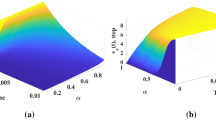Abstract
In this work, we consider the design of third-order oscillators that are built around a multi amplifier structure with two- or three-amplifiers topologies. We derive all the possible oscillators that could be constructed using combinations of RC or RLC elements and provide the oscillation frequency and the oscillation start-up condition in each case. Multi-outputs are produced from the topology with phase-shift relationships that are governed by impedance ratios. All the reported RLC oscillators are canonical and require only three reactive elements and one resistor. Parasitic effects are considered for a sample designed oscillator circuit and chaos generation as a possible application is demonstrated. Circuit simulations using Spice and experimental results are given to verify the theory.








Similar content being viewed by others
Data availability
Data sharing not applicable to this article as no datasets were generated or analyzed during the current study.
References
M. Azadmehr, I. Paprotny, L. Marchetti, 100 Years of Colpitts oscillators: ontology review of common oscillator circuit topologies. IEEE Circuits Syst. Mag. Fourth Quart. 2020, 8–27 (2020)
D.R. Bhaskar, Garima, P. Kumar, A. Raj, Third-order quadrature sinusoidal oscillators employing OTRAs with independent control of oscillation condition and frequency of oscillation. J. Circuits Syst. Comput. 32(18), 2350310 (2023). https://doi.org/10.1142/S0218126623503103
D.R. Bhaskar, A. Raj, P. Kumar, New resistorless third-order quadrature sinusoidal oscillators. J. Circuits Syst. Comput. 30(11), 2150194 (2021)
D.R. Bhaskar, A. Raj, P. Kumar, New resistorless third-order quadrature sinusoidal oscillators. J. Circuits Syst. Comput. 30(11), 2150194 (2021). https://doi.org/10.1142/S0218126621501942
R. Bhaskar, A. Raj, R. Senani, Third-order quadrature sinusoidal oscillators with fully uncoupled tuning laws using only two CFOAs and grounded capacitors. Int. J. Circuit Theory Appl. 51(6), 2981–2992 (2023)
H.P. Chen, Y.S. Hwang, Y.T. Ku, A systematic realization of third-order quadrature oscillator with controllable amplitude. AEU-Int. J. Electron. Commun. 79, 64–73 (2017). https://doi.org/10.1016/j.aeue.2017.05.039
H.P. Chen, Y.S. Hwang, Y.T. Ku, Voltage-mode and current-mode resistorless third-order quadrature oscillator. Appl. Sci. 179(7), 1–18 (2017)
H.P. Chen, Y.S. Hwang, Y.T. Ku, Voltage-mode and current-mode resistorless third-order quadrature oscillator. Appl. Sci. 7(2), 179 (2017). https://doi.org/10.3390/app7020179
A. Elwakil, M. Kennedy, A semi-systematic procedure for producing chaos from sinusoidal oscillators using diode-inductor and FET-capacitor composites. IEEE Trans. Circuits Syst. I Fundam. Theory Appl. 47(4), 582–590 (2000). https://doi.org/10.1109/81.841862
A. Elwakil, B. Maundy, C. Psychalinos, On the realization of an amplifier-tuned low/high frequency family of oscillators. Int. J. Circuit Theory Appl. (2024). https://doi.org/10.1002/cta.4038
A.S. Elwakil, S. Ozoguz, K.N. Salama, Sinusoidal oscillators with lower gain requirements at higher frequencies based on an explicit tanh(x) nonlinearity. Int. J. Circuit Theory Appl. 38(7), 747–760 (2010). https://doi.org/10.1002/cta.592
A.S. Elwakil, K.N. Salama, Higher dimensional models of cross-coupled oscillators and application to design. J. Circuits Syst. Comput. 19(04), 787–799 (2010). https://doi.org/10.1142/S021812661000644X
U.S. Ganguly, Extended-range parallel-path RC oscillator synthesis: a state-variable approach. Electron. Lett. 21, 1048–1050 (1985)
M. Ghosh, S.S. Borah, A. Singh, A. Ranjan, Third order quadrature oscillator and its application using CDBA. Analog Integr. Circuit Signal Process. 107, 575–595 (2021)
H.L. Hartnagel, E. Tlelo-Cuautle, C.W. Chiou, B. Chaturvedi, S. Maheshwari, Third-order quadrature oscillator circuit with current and voltage outputs. ISRN Electron. 2013, 385062 (2013). https://doi.org/10.1155/2013/385062
M. Joshi, Kirti, P. Thakur, Design and implementation of third order oscillator using CFOA and OTA. In: Proceeding of the International Conference on Electrical, Computer and Energy Technologies (ICECET) (2021)
B. Maundy, A. Elwakil, C. Psychalinos, Systematic realization of tunable-phase third-order oscillators. AEU-Int. J. Electron. Commun. 170, 154806 (2023). https://doi.org/10.1016/j.aeue.2023.154806
B. Maundy, A. Elwakil, C. Psychalinos, A novel family of tunable-frequency oscillators. AEU Int. J. Electron. Commun. (2024). https://doi.org/10.1016/j.aeue.2024.155219
B.J. Maundy, A. Elwakil, Third-order tunable-phase asymmetric cross-coupled oscillator. IET Circuits Devices Syst. 13, 929–933 (2019)
A. Raj, D.R. Bhaskar, P. Kumar, Two new third-order quadrature sinusoidal oscillators. IETE J. Res. 69(3), 1661–1674 (2021). https://doi.org/10.1080/03772063.2021.1874841
A. Raj, P. Kumar, D.R. Bhaskar, R. Senani, New very-low-frequency third-order quadrature sinusoidal oscillators using CFOAs. Circuits Syst. Signal Process. 41(8), 4293–4323 (2022). https://doi.org/10.1007/s00034-022-02006-6
R. Senani, New RC-active oscillator configuration employing unity-gain amplifiers. Electron. Lett. 21(20), 889–891 (1985)
R. Senani, Network transformations for incorporating non-ideal simulated immittances in the design of active filters and oscillators. IEE Proc .G Electron. Circuits Syst. 134(4), 158–166 (1987)
R. Senani, D.R. Bhaskar, V.K. Singh, R.K. Sharma, Sinusoidal oscillators and waveform generators using modern electronic circuit building blocks. In: Springer International Publishing (Springer, 2016), pp. 269–366
G. Shukla, S.K. Paul, Third-order quadrature oscillator with arbitrary phase shift generation and amplitude modulation using MDXCCCTA. IEEE Trans. Instrum. Meas. 72, 1–16 (2023). https://doi.org/10.1109/TIM.2023.3300449
A.M. Soliman, Simple sinusoidal active RC oscillators. Int. J. Electron. 39(4), 455–458 (1975)
A.M. Soliman, Generation of third-order quadrature oscillator circuits using NAM expansion. J. Circuits Syst. Comput. 22(7), 1360–1373 (2013)
Author information
Authors and Affiliations
Corresponding author
Ethics declarations
Conflict of interest
We declare that we do not have any commercial or associative interest that represents a conflict of interest in connection with the work submitted.
Additional information
Publisher's Note
Springer Nature remains neutral with regard to jurisdictional claims in published maps and institutional affiliations.
Rights and permissions
About this article
Cite this article
Elwakil, A.S., Maundy, B.J. & Psychalinos, C. New Third-Order Oscillators Using Two or Three Amplifiers. Circuits Syst Signal Process (2024). https://doi.org/10.1007/s00034-024-02712-3
Received:
Revised:
Accepted:
Published:
DOI: https://doi.org/10.1007/s00034-024-02712-3




